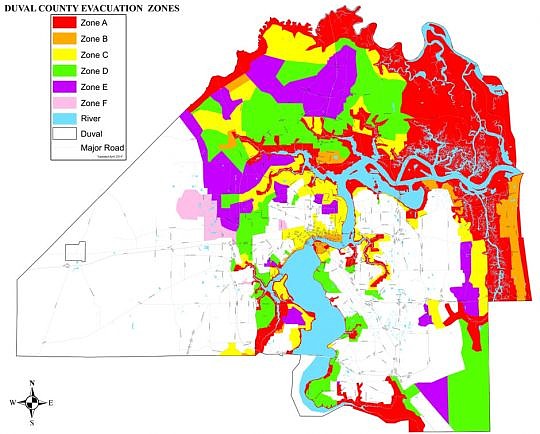
Hurricane season starts the first day of June — it’s a date that hasn’t changed in decades.
What is changing this year, at least locally, is how Duval County’s evacuation zones are defined.
Gone are the sections of town labeled by Category 1 or 2 (like much of the Beaches) or Category 4 (parts of Northwest Jacksonville). That map hadn’t been updated since 2005 and lacked some key information, officials said.
“It was based on the category of storm from one to five,” said Steve Woodard, center director. “Most people don’t realize that category was only based on wind speed, period.”
Storms of such magnitude don’t just mean wind damage, though. It’s the storm surge, flooding and possible isolation points that can cause damage.
With technology advances, determining when people should flee a disaster has improved. The city’s Emergency Operations Centers has updated its color-rich evacuation maps and replaced those categories with “zones.”
More than 1,000 storm models take into account the St. Johns River, flood and isolation areas, the angle a storm can take and its sheer size. With the different water bodies, Duval County was one of the more complex to model, Woodard said.
While being in Evacuation Zone A might look similar to the former Category 1 overlay, for example, the two aren’t correlated, said Alex Pellom, a city emergency preparedness planner.
The new evacuation zones have been updated on the center’s JaxReady iPhone and Android apps, which officials are encouraging people to use. Plugging in an address and GPS can determine what zone an address is in or determine what sector a person currently is in.
The city’s website with the similar information on the zones should be updated within a couple of days. Printed versions with the zones and information will be available at area Winn-Dixie stores in the coming weeks and as an insert in The Florida Times-Union on Sunday.
Along with the new models, old advice is still first.
“Learn your zone,” said Woodard.
Pellom said learning the zones of family members and loved ones along with memorizing multiple evacuation routes is important. The routes haven’t changed, but instead have become “cleaner” this year, Pellom said.
The evacuation system won’t be just for storms, though. It’s an all-hazards approach that can assist emergency operators during wildfires, floods and other disasters.
@writerchapman
(904) 356-2466